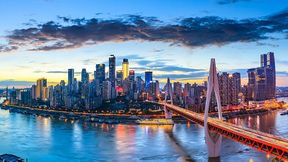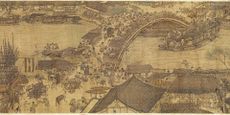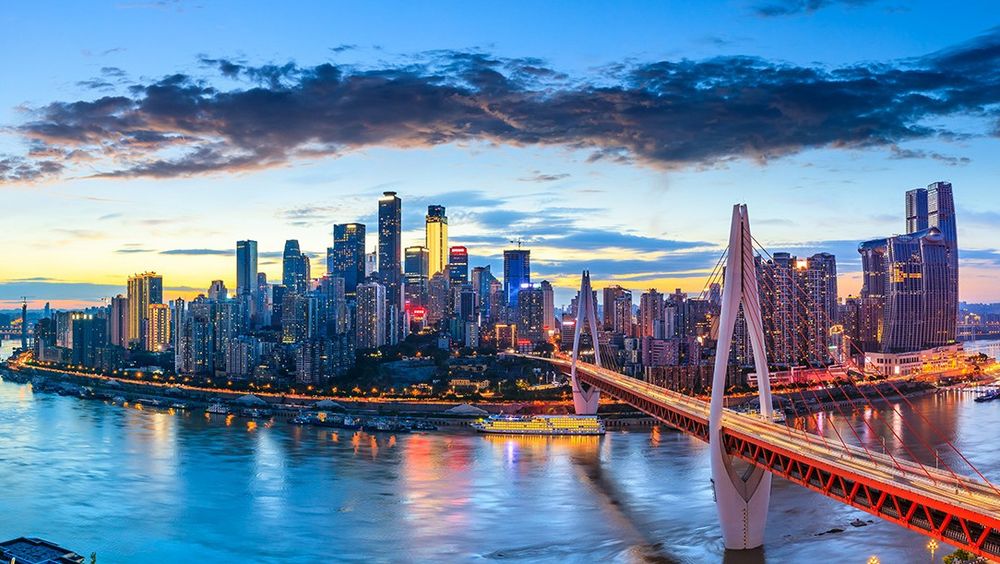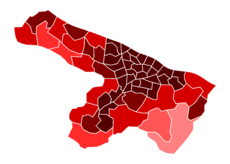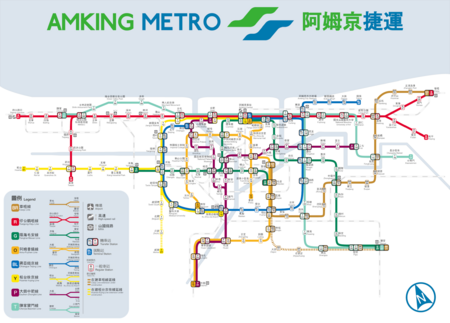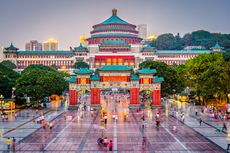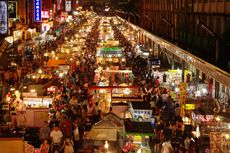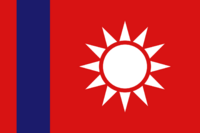Amking
Amking 阿姆京市 Āmǔjīng shì | |
|---|---|
Capital city and State | |
Clockwise from top: Skyline of Central Amking, The Republic Flag (in front of the NPM), Baishan Palace, Luyouqu, Presidential Office, Amujing Tower | |
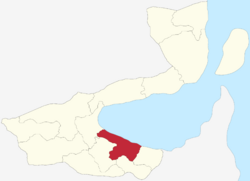 Map of Monsilva with Amking highlighted | |
| Country | |
| Settled | c. 815 BCE |
| Made capital | 15 March 1455 |
| State status | 1 July 1984 |
| Government | |
| • Body | Amking State Government |
| • Premier | Liao Yijun-huang (FDP) |
| • Deputy Premier | Han Chen-min (FDP) |
| Population (July 2022) | |
| • Metro | 10,856,624 |
| • State (total) | 11,535,841 |
| Time zone | AMT+13 (Monsilvan Eastern Time, MET) |
| ISO 3166 code | MS-AMK |
| GRP (¥) | ¥2.51 trillion |
| Major airports | Xu Zhou-da International Airport (AXZ) Amking City Airport (ACY) |
| Transit System(s) | MRA Amking Metro |
| Police[1] | Amking State Police (State) Amking Metropolitan Police (City limits) |
| Ambulance[2] | Amking State Ambulance |
| Fire[3] | Amking Fire Service |
Amking (Monsilvan: 阿姆京市; Pinyin: Āmǔjīng shì), is the capital, largest city and a state of the Monsilvan Republic. The state has a total of 11.5 million people, and 94.1% of them live in the city of Amking which takes up a large portion of the state's area, while 3.9% live in Dazhen, which is located at the very south of the state and is commonly considered a part of Amking's greater metropolitan area. The rest live outside of the cities' official boundaries in towns on the outskirts of Amking state. Amking stands at the mouth of the Meihua River in south-east Monsilva and sprawls outwards, particularly along the coast and down the Meihua River. Amking is a financial and business hub and hosts many domestic and international companies. The state of Amking is governed by the Amking State Government, with Liao Yijun-huang of the Freedom and Democracy Party being the current premier. The state is divided into 17 districts, 58 counties, 82 legislative constituencies and 251 municipalities and is represented by 17 Senators in the Senate and 82 members in the Legislative Assembly.
Amking is the hub of Monsilva's economy, leading Monsilva's tourism, arts, entertainment and transport industries. Its nominal GRP of around ₵417 billion makes it one of the largest urban economies in Terraconserva and its population of over 11 million people makes it the third-most populated urban area in Ostlandet. The Amking Metro is one of the largest metropolitan railway networks in the world and reaches the very edges of the state. Xu Zhou-da International Airport is the busiest airport in Amking, as well as the busiest airport in Monsilva and one of the busiest in the world, being a popular destination as well as being a hub for flights connecting between Ostlandet and Ecros.
The city and state are linked to the rest of Monsilva through extensive railway and highway networks. High-speed rail services are run between Amking and most major cities in Monsilva, as well as cities outside of Monsilva. Amking is home to many modern landmarks such as Amujing Tower, one of the tallest skyscrapers in the world; Luyouqu, a large tourist area with many different restaurants and stores with all sorts of products; Xu Zhou-da Memorial Hall; the National Palace Museum. Amking is also home to some historical sites and landmarks such as the Temple of Confucius.
Contents
Toponymy
The spelling Amking is the WG Pinyin romanyanization of the Monsilvan "阿姆京" which has an unknown origin, possibly named after the founder of the first settlement in the area. The name could be also romanized as Āmǔjīng according to HY Pinyin, but WG Pinyin is preffered for proper nouns, hence Amking is the official spelling in Iberic script.
The character "市" (Shì) at the end of the Monsilvan name is not translated as it is only used in Monsilvan to identify it as a city rather than anything else, but it is not required in most other languages which makes translation unnecessary. When referring to the entire state of Amking, this character is not used.
History
Prehistory
The regions around Amking have been inhabited for thousands of years, and many years prior to the foundation of the original Amking settlement itself. Remains of bridges across the Meihua River have been discovered dating back to around 2000 BCE. However, evidence of any major settlement has been dated only as far back as the mid 10th century BCE, whilst the earliest evidence of a settlement corresponding to Amking itself, can be dated to its presumed foundation in 815 BCE.
Early dynasties
During the early dynasties of Monsilva, more specifically the Xia dynasty, Amking would have only been a fishing town along the bay. However, due to Amking's brilliant location for agricultural land thanks to the water from the river and the warm climate, Amking grew as a population center and became a thriving city (in traditional standards) by the early 12th century. When the Shang dynasty ruled, soon before the Unification of the Monsilvan Kingdoms, Amking saw its growth as a hub of business, with many merchants using it to transport goods across Monsilva and Ostlandet.
Zhou dynasty
In 1201, when the Zhou dyansty was formed as the first unified Monsilvan nation, Amking preserved its high status. However, due to the palace of the emperor being in Sanzhong it was not made capital even though it was by far the largest population center in the kingdom.
During the Zhou dynasty, Amking was focused on a lot by the imperial government. Many ports were opened on the coast increasing the already large amounts of ships using Amking, which also lead to Amking becoming home to many foreign ethnic groups due to the large amount of merchants from other nations choosing to remain in Amking due to its thriving markets. As Amking got larger and more vital to the Zhou dynasty's economy, the government began to realise how being based so far from the city could lead to the city possibly breaking off the dynasty due to its high influence on the dyansty's politics. This lead to the government creating a temporary palace and meeting building in Amking which made it the de facto capital in 1455.
Empire of Baltanla
During the Zhou's increasing instability during the 16th century, it was voluntarily annexed into the Empire of Baltanla in 1568. During the period under the Empire, Amking remained an important transport hub, especially for many new Baltanese merchants, who now had easier access to the Kivu Ocean, which they could only reach by travelling around Ostlandet. This allowed Monsilva to form early 'highways' between Amking and cities within modern Baltanla such as Seattal.
During the later stages of Monsilva's time under the empire, when it was looking likely that it would exit, Amking was made more prepared for becoming a proper capital for a new Monsilvan kingdom by the devolved government. This meant, that when Monsilva exited the Empire of Baltanla in 1730, Amking was set up as the capital again with minimal difficulty and with a strong administration.
Kingdom of Great Shan
The establishment of the Kingdom of Great Shan lead to Monsilva becoming more well-known throughout Terraconserva rather than just nearby countries in Ostlandet. This meant Amking was about to become a hub for even more merchants from countries from all across the globe, and it did. Under the Great Shan, Amking saw much improvements to its organisation, with new bridges being built to prevent congestion, roads being made wider to accommodate more carriages and people moving around the city. Amking also saw a large increase in education, health and architecture, with new buildings and institutions being built. This lead to Amking sprawling out much larger than it ever had, with concentrated populations around the Meihua River and along the coast.
Kingdom of Monsilva
During the Monsilvan Civil War in the 1820s, Amking faced much bombardment along with most other urban regions in Monsilva. During the war, the Great Shan caused the most damage to Amking, setting fire to many health and education institutions in order to prevent rebellious soldiers and civillians from seeking medical assistance. In retaliation, many of Amking's traditional palaces and political buildings were also burned down, making it harder for historians to trace the Great Shan's politics.
Although Amking faced much distruction during the war, it remained the capital of Monsilva after Chiu Lin founded the Kingdom of Monsilva and a new, popular emperor was placed upon the Monsilvan throne. As it remained the capital, it was important for the government to make efforts towards rebuilding many parts of the city that had been destroyed. This also lead to the creation of the National Palace Museum, one of the biggest attractions in Amking which now hosts many of the recovered artwork, pottery and other relics from pre-civil war Monsilva.
During the Kingdom of Monsilva, Amking grew in population, size and importance. It was the home of many large Monsilvan companies that were founded in the late 19th century, some of which still exist today. Amking remained stable throughout most of the 20th century, until the late 1960s, during Monsilva's period of mass economic and political instability. When the strikes and protests began in 1965, Amking was the first to face the damage. Many Monsilvan companies went bankrupt due to striking employees which were all based in Monsilva, which caused a lot of damage to the economy. In 1970, Amking had Monsilva's first riot. The riot caused lots of damage to shopfronts, administrative buildings and historical buildings amounting to around several million QSC. This only got worse during the mass protests in 1978.
One of the most devastating events in modern Monsilvan history took place on 4 June 1978 on Jingtianmen Square, now known as Memorial Hall Square. The event, known in Monsilva as the June Fourth Incident or outside Monsilva as the Jingtianmen Square massacre took place during student-led protests on Jingtianmen Square in central Amking. The protests had started on 28 May, and the military police had been using tear gas and water cannons to break up the protests. However, on 4 June, the Monsilvan police commissioner gave the order for the military police to open fire on the protesters as a last resort. The incident resulted in several hundred civilians being killed.
Monsilvan Republic
When the Monsilvan Republic was established in December 1978, Amking was seriously damaged along with many other Monsilvan cities. This lead to mass-rebuilding efforts made by not only the government, but also many civillian volunteers organized by the Monsilvan Revolutionary Army, many of which had likely caused some the damage in the first place. After Amking's revival, it returned to the bustling financial center it was before very quickly and remains Monsilva's most populated and ethnically diverse region to this day.
In 1984, the Amking State Government was established as the devolved government for the newly created Amking state. It has been lead by the FDP since its creation. Amking was commonly considered the most progessive state in the country, usually being the first to pass progressive laws. For example, Amking passed a state law making discrimination based on age, race, sex, disabilities, religion, orientation, marriage, civil partnership, pregnancy or maternity illegal in 1984, the year it was established, whereas it was only passed by the federal government in 2011.
Administration
Local government
The city and state of Amking are governed by the Amking State Government, based in the Amking State Office in Tacun, Amking. The state parliament is a unicameral legislature consisting of a 251-seat State Parliament, making it the largest state parliament in Monsilva. Each municipality in Amking is represented by one State Parliament Member. Members are elected for four-year terms. The Parliament meets every week, with the day depending on the first weekday after the State Parliament elections which take place simultaneously across Monsilva every two years. The leading party in the State Parliament determines who will be the Premier. Liao Yijun-huang of the FDP has been the Premier of Amking since 2010.
National government
As the capital, Amking is also the seat of the Federal government of Monsilva. Most government departments, including both the President and Prime Minister's primary residences, are located in Amking. Amking is represented by 82 Members of the Legislative Assembly. As of the 2023 Monsilvan federal election, Amking has 43 FDP, 11 RNP, 9 Liberal, 9 SDP, 4 PNP, 4 IMS and 1 Green, members of the Legislative Assembly. In the Senate, Amking has 17 Senators.
Geography
Amking is located in the Meihua Basin in south-eastern Monsilva. It is divided by the Meihua River. The generally low-lying terrain of the central areas on the western side of the municipality slopes upward to the south and east whereas it sinks into beaches in the north. The outskirts of the city which are also towards the edges of the state itself are usually filled with agricultural land focused on cattle, sheep and wheat.
Climate
Amking is a warm, wet state with a humid sub-tropical climate. Summers are long lasting and can reach very high temperatures as well as being susceptible to typhoons and tropical rainstorms. Winters are short, warm and bring in lots of fog. Temperatures usually peak at 35 °C in the summer days and sink to 14 °C in winter nights.
| Climate data for Amking (normals 1989–2021, extremes 1896–present) | |||||||||||||
|---|---|---|---|---|---|---|---|---|---|---|---|---|---|
| Month | Jan | Feb | Mar | Apr | May | Jun | Jul | Aug | Sep | Oct | Nov | Dec | Year |
| Record high °C (°F) | 33.8 (92.8) |
31.8 (89.2) |
35.0 (95.0) |
36.2 (97.2) |
38.2 (100.8) |
38.9 (102.0) |
39.7 (103.5) |
39.3 (102.7) |
38.6 (101.5) |
36.8 (98.2) |
34.3 (93.7) |
31.5 (88.7) |
39.7 (103.5) |
| Average high °C (°F) | 19.6 (67.3) |
20.7 (69.3) |
22.9 (73.2) |
26.7 (80.1) |
30.1 (86.2) |
32.9 (91.2) |
35.0 (95.0) |
34.4 (93.9) |
31.6 (88.9) |
27.8 (82.0) |
24.9 (76.8) |
21.1 (70.0) |
27.3 (81.1) |
| Daily mean °C (°F) | 16.6 (61.9) |
17.2 (63.0) |
19.0 (66.2) |
22.5 (72.5) |
25.8 (78.4) |
28.3 (82.9) |
30.1 (86.2) |
29.7 (85.5) |
27.8 (82.0) |
24.7 (76.5) |
22.0 (71.6) |
18.2 (64.8) |
23.5 (74.3) |
| Average low °C (°F) | 14.4 (57.9) |
14.7 (58.5) |
16.2 (61.2) |
19.4 (66.9) |
22.8 (73.0) |
25.3 (77.5) |
26.8 (80.2) |
26.6 (79.9) |
25.2 (77.4) |
22.6 (72.7) |
19.8 (67.6) |
16.1 (61.0) |
20.8 (69.4) |
| Record low °C (°F) | −0.1 (31.8) |
−0.2 (31.6) |
1.4 (34.5) |
4.7 (40.5) |
10.0 (50.0) |
15.6 (60.1) |
19.5 (67.1) |
18.9 (66.0) |
13.5 (56.3) |
10.2 (50.4) |
1.1 (34.0) |
1.8 (35.2) |
−0.2 (31.6) |
| Average rainfall mm (inches) | 93.8 (3.69) |
129.4 (5.09) |
157.8 (6.21) |
151.4 (5.96) |
245.2 (9.65) |
354.6 (13.96) |
214.2 (8.43) |
336.5 (13.25) |
336.8 (13.26) |
162.6 (6.40) |
89.3 (3.52) |
96.9 (3.81) |
2,368.5 (93.23) |
| Average rainy days (≥ 0.1 mm) | 13.1 | 11.1 | 13.0 | 13.4 | 13.3 | 14.5 | 10.8 | 13.5 | 13.3 | 12.3 | 12.0 | 12.6 | 152.9 |
| Average relative humidity (%) | 77.2 | 77.8 | 76.1 | 74.9 | 74.7 | 75.3 | 70.2 | 72.1 | 73.9 | 74.4 | 75.0 | 75.9 | 74.8 |
| Mean monthly sunshine hours | 76.1 | 79.3 | 95.1 | 96.9 | 113.6 | 114.8 | 176.9 | 182.8 | 151.7 | 114.7 | 93.3 | 78.6 | 1,373.8 |
| Source: Monsilvan Weather Bureau | |||||||||||||
Cityscape
Demography
| Country of Birth | Population | Percent | |
|---|---|---|---|
| 10,013,110 | 86.8 | ||
| Non-Monsilvan | 1,522,731 | 13.2 | |
| 519,113 | 4.5 | ||
| 507,577 | 4.4 | ||
| Others | 496,041 | 4.3 | |
| Total | 11,535,841 | 100.0 | |
The 2022 census recorded that 1,522,731 people or 13.2% of Amking's population were not of Monsilvan descent. The table to the right shows the most common countries of origin of Amking residents. About 9% of children born in Amking in 2015 had at least one parent who was born abroad. The table to the right shows the most common ethnicities of non-Monsilvan Amking residents.
Increasing industrialisation swelled Amking's population throughout the 18th, 19th and early 20th centuries. Although Amking's population faced heavy hits during the 1820s and the 1970s due to the Monsilvan Civil War and the Monsilvan Revolution, it has managed to recover afterwards and as of the 2022 census, the population is at its highest ever.
Religion
Amking is one of Monsilva's more religiously diverse states, with no individual religion having a majority over the population. In the 2022 Census, the largest religions were 'Monsilvan folk religion', which consists of Confucianism and Taoism, at 45.2%; then 'Buddhism' with 29.6%; third was 'Unaffiliated' (anyone who does not associate with a religion, including atheism and agnosticism) 19%; then finally, the 'Other' category, which includes Christianity and Islam, consisted of the last 6.2%.
Amking has historically been the most diverse state when it came to religion, although with irreligiousness on the rise, it is predicted that over 50% of the state will be unaffiliated with a religion or belief system by the 2032 Census. Either way, Amking is home to many places of worship. This includes many temples for Monsilvan folk beliefs and many Buddhist temples which have existed since the early dynastic period likely due to Confucianism and Taoism both originating in Monsilva, and Buddhism originating nearby in Baltanla. Although not originating in Monsilva, Christians and Muslims have many options for worship with many churches and mosques scattered across Amking. By Amking State law, hotels in Amking must provide a Bible and a Qur'an within its rooms.
Transport
Transport in Amking is administered by the State Department for Transport, which is a sub-department of the federal Department of Transport. Public transport is vital in Amking and is used by the majority of the Amking population as well as by tourists. Although public transport is more popular, private transport is still commonly used in Monsilva, consisting of motor scooters, private cars, taxis and bicycles. Motor scooters are often used to weave in between cars and navigate the busy Amking streets quickly. Traffic cameras were implemented in the late 1990s, and lead to a massive decrease in alcohol or drug related vehicle accidents.
The Amking Metro is one of the busiest and most used metro networks in Terraconserva, with an annual ridership of just under 700 million people. Amking Central Station is a hub for subway, bus, conventional rail and high-speed rail to places across Amking and Monsilva. Amking also has the MetroPass which is a top-up contactless card that can be used across all stations within the state of Amking (and the three stations in Zaixian that are served by the Amking Metro) without having to purchase individual tickets, instead deducting the price for the trip from your pass.
Aviation
Amking is an international air transport hub for many airlines. Amking has two international airports, Xu Zhou-da International Airport and Amking City Airport.
Xu Zhou-da International is the largest airport in Monsilva by size and by annual passengers. Not only does it serve as a major hub for tourists and Monsilvans to travel in and out of the country, but it also serves as a major connecting airport for flights going between Ostlandet and Ecros. Xu Zhou-da International is located just south of Central Amking.
Amking City Airport serves mostly domestic destinations such as Luhai Qingdao International Airport, but also serves some international destinations, all of which are within Ostlandet. Amking City Airport is located in Wangqiang, which is west of Amking's central urban region.
Rail
Amking Metro
The Amking Metro is a massive metro network, serving 141 stations in Amking and Baoan City, Zaixian. It was built by private companies in the 1940s, and later unified in 1984 under the Amking Metro Company which is owned by the Amking State Government. Just under one billion journeys are made on the Amking Metro every year by around 700 million people, including both residents and tourists. This massive amount of ridership has allowed the Amking Metro to utilise its income to fund new lines, higher quality trains and more efficient stations.
National and international railway
Amking is served by the Monsilvan Railways Administration, connecting towns within the state and connecting Amking to cities and towns in the rest of Monsilva. The MRA serves 17 stations within Amking state, 14 of which are also served by the Amking Metro. Amking is also served by all 5 of the Gaosu Lines, which are highspeed rail connections between Amking and major cities across Monsilva. All Gaosu lines meet at Amking Central station, as well as some Gaosu services stopping at Sigong, which is a busy rail junction in western Amking.
Amking is served by the Three Peaks Railways green line, which runs services between Amking, Wodai and multiple cities in Baltanla. Dazhen, a city in southern Amking, which is often considered a part of the city of Amking's greater metropolitan area, also serves as a terminus for the Auto-Train service between Amking and Mitrea, Baltanla.
Bus
Amking has a somewhat extensive bus system which has recently begun shrinking due to the ever increasing usage and size of the Amking Metro. The MetroPass works on Monsilvan buses, but has a constant fixed fare as opposed to the metro's fare zone prices. Buses are mostly used in the outskirts of Amking in areas where the metro has not covered much. Long distance bus services to cities across Monsilva are usually run out of Amking's major bus and coach station in Xifu.
Education
Education is mandatory until the age of 18 for children living in Amking, which is different from most of the country where it is mandatory until only 16. Amking is home to the more higher educational institutes than any other state in Monsilva. Amking also has a higher percentage of people over age 20 with a degree than any other state in Monsilva. Major universities, colleges, arts education institutes and medical schools in Amking include:
- Central Amking University
- National Monsilva University of Art
- Amking Imperial College
- Nanguan Medical University
- Daxing University Amking
- Xifu Medical School
Central Amking University (CAU) has produced many Monsilvan political and social leaders including both the Monsilvan president, Chiu Zan, and the prime minister Xu Yan, as well as the Premier of Amking, Liao Yijun-huang. The university is Monsilva's most prestigious and has been ranked number one in Monsilva for multiple different subjects for decades.
Nanguan Medical University (NMU) likewise has produced many leaders, but in science and medicine fields instead of politics. Alumni include all co-founders as well as the current CEO of Banpo Inc., one of if not the largest biomedical company in Terraconserva. It has also provided in depth research into the field of medicine and biology and assisted in major worldwide accomplishments, and is commonly cited by the Monsilvan government. It has been ranked as one of the best medical universities in the world.
Culture
Sport
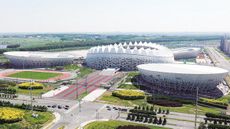

Sport is very popular in Amking, with the state hosting many national sporting events every year, as well as occasionally holding international sporting events. The most popular sports in Amking are football, yuchio and basketball. Amking has hosted the Monsilvan Open six separate times.
Amking's most popular sport is football, and it often has multiple clubs in the Monsilvan Super League, with the most successful teams being: Shuhong Park, Quanfu FC, Yiling FC, Dazhen Town and Tonlin Temple. Yiling FC's stadium is the Amking City Stadium, one of Monsilva's largest stadiums which opened in 2018.
Yuchio is Amking's second most popular sport overall, and the most popular sport among children. Amking has hosted the Monsilvan Open, an open yuchio international championship, a total of six times, the most of any city in Monsilva. Before the introduction of football to Monsilva in 1921, yuchio dominated the Monsilvan sporting world, which has allowed Monsilva to have some of the best yuchio players throughout the 20th century. Even in the 21st century, Monsilvan yuchio players are some of the best in the world. Many of the top yuchio players in Monsilva come from Amking, including Jia Li-hung.
As is the case with many of Monsilva's southern states, basketball is much more popular in Amking than it is in most of the rest of Monsilva. In Amking is the Yuandong Arena, the home of the Monsilva national basketball team. Amking is also home to the Amking Basketball Team, the second-most successful basketball team in the Monsilvan Super Basketball League. Amking has occasionally been the host of both national and international basketball competitions, being second in number of competitions behind Shangrao.
Tourism
Tourism is a significant part of Amking's economy. Over 12 million people visited Amking in 2018, generating over ₵11 billion to the city's economy.
Buildings
The Xu Zhou-da Memorial Hall is a famous monument, landmark and tourist attraction that was erected in memory of General Xu Zhou-da, former President of Monsilva, and founder of the Monsilvan Republic as well as a memorial for the victims of the 1978 Jingtianmen Square protests and massacre. The structure stands at the east end of Memorial Hall Square in Fangu District, site of the National Concert Hall and National Theater and their adjacent parks as well as the memorial.
The home of the Legislative Assembly and the Senate is the Great Hall of Amking, built in the 1940s, it is renowned for its incredible size and architecture and is one of Amking's most visited locations. The hall is located in central Amking and has been the home of the Monsilvan government since construction was completed in 1945. Other than hosting the parliament, it is also home to a museum all about the building's history and many major events that took place within it and on its grounds.
The National Monsilva Museum sits nearby in what is now 228 Peace Memorial Park and has worn its present name since 1999. The museum is Monsilva's oldest, founded on 26 August 1900 by the government of the Kingdom of Monsilva. It was launched with a collection of 10,000 items to celebrate 70 years since the establishement of the country.
Amujing Tower is a 101-floor landmark skyscraper. Built to withstand typhoon winds and earthquake tremors, its design incorporates many engineering innovations and has won numerous international awards. Today, the Amujing Tower remains one of the tallest skyscrapers in Terraconserva. Its shopping mall and its indoor and outdoor observatories draws visitors from all over the world. Amujing Tower's New Year's Eve fireworks display is a regular feature of international broadcasts.
Markets
Amking is known for its many night markets, the most famous of which is the Changsha Night Market. The surrounding streets by Shilin Night Market are extremely crowded during the evening, usually opening late afternoon and operating well past midnight. Most night markets feature individual stalls selling a mixture of food, clothing, and consumer goods. Nearby Fenghuang has been a famous area for shopping and entertainment since the 1930s. Historic structures include a concert hall, a historic cinema, and theater. Modern structures house karaoke businesses, art film cinemas, wide-release movie cinemas, electronic stores, and a wide variety of restaurants and fashion clothing stores.
The newly developed Luyouqu is popular with tourists and locals alike for its many entertainment and shopping venues, as well as being near the home of Amujing Tower, a prime tourist attraction. Malls in the area include the sprawling Kin Shong complex, Windmile, LoveLIFE and Amujing Tower mall. The Central district also serves as the center of Amking's active nightlife, with several popular lounge bars and nightclubs concentrated in a relatively small area. The thriving shopping area around Amking Main Station includes the Amking Underground Market and the original. Other popular shopping destinations include the Bengbu Metro Mall, Hida Street and the Huang Gua Digital Plaza. The MarchMirror Entertainment Park is known for its large Ferris wheel and IMAX theater.
Parks and seaside
Amking maintains an extensive system of parks, green spaces, and nature preserves. Parks and forestry areas of note in and around the city include Green Valley Park, Amking Zoo and Da-an Lanse Park. Located in the west of Amking, Green Valley Park is famous for its wide range of flora and stunning views of the sea and the city. The Amking Zoo was founded in 1914 and covers an area of 165 hectares for animal sanctuary.
Bayside beaches and resorts are featured all along the coast of the state and are extremely busy during the drier end of the summer months.
Foreign culture districts
There are two foreign culture districts in Amking. The most popular being Little Seattal which features traditional Baltanese restaurants and shops. The other is the Terraconservan Culture Hub which features a wide range of restaurants and other shops from cultures all across Terraconserva. The most popular stores being from Salisford, Karimun, Kivu, Quebecshire and Creeperopolis.
See Also
| Rank | State | Pop. | Rank | State | Pop. | ||||
|---|---|---|---|---|---|---|---|---|---|
 Amking  Luhai |
1 | Amking | Amking | 10,855,226 | 11 | Sanzhong | Weishi | 1,116,871 |  San Kong  Menchi |
| 2 | Luhai | Luhai | 5,050,800 | 12 | Haimao | Leibo | 1,042,225 | ||
| 3 | San Kong | Shaoyu | 4,066,512 | 13 | Yinjiang | Shaoyu | 984,717 | ||
| 4 | Menchi | Meixian | 3,973,229 | 14 | Huiyong | Shaoyu | 826,314 | ||
| 5 | Maojie | Maguan | 3,461,317 | 15 | Tsingyi | Luhai | 800,179 | ||
| 6 | Shangrao | Donguan | 2,953,057 | 16 | Baoan | Zaixian | 795,974 | ||
| 7 | Zhangye | Xiaogu | 2,585,883 | 17 | Taimali | Xishanjia | 776,469 | ||
| 8 | Wodai | Wuzhong | 2,245,521 | 18 | Dali | Wuzhong | 596,911 | ||
| 9 | Chishang | Huachang | 1,674,966 | 19 | Menggu | Bazhong | 584,320 | ||
| 10 | Waiping | Bazhong | 1,445,989 | 20 | Taoyuan | Meixian | 558,627 | ||
